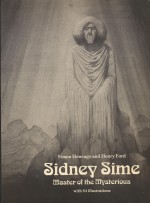
By Simon Heneage & Henry Ford (Thames and Hudson)
ISBN: 0-500-27154-2
A little while ago I mentioned with due reverence the wonderful illustrator Sidney Herbert Sime: late Victorian, Edwardian and latterly Georgian master of fantasy art whose stunning and imaginative pictorial forays into the realms of fable, myth and literary romanticism influenced two generations of readers and creators, but who is these days all but forgotten.
Not On My Watch…
Sime is archetypal of the rag-to-riches-to-obscurity fate which befell so many talented individuals of this period (for instance, do you know who Arthur Machen, William Hope Hodgson or even William Friese-Greene were?). After pulling himself up by his bootstraps, Sime became a celebrated and notable society figure thanks to his unique creations before changing modes and his own uncompromising nature isolated him from rapidly evolving times and tastes.
There aren’t too many tomes celebrating his work (this one is still available through a few internet dealers, though) but you can still see many of his original works if you visit the Sidney Sime Memorial Gallery in Worplesdon, near Guildford in Surrey.
After Acknowledgements and an Introduction, a short, erudite essay – packed with supporting artworks – describes the artist’s beginnings in ‘The Early Years’, disclosing that we don’t really know when he was born (sometime between 1865-1867 in Hulme, Greater Manchester) before going on to describe how the second son of six fathered by a warehouseman worked as a child in coal mines, as a linen draper, in a bakery, barbers and a shoemakers: voraciously self-educating, busking music and creating pictures to sell in his off-hours.
He graduated to sign-writing and found the funds to attend Liverpool School (later College) of Art, then joined the University of Liverpool before moving to London, winning artistic awards and securing commercial commissions in many newspapers and especially ‘The Magazines’ such as Pick-Me-Up, Pall Mall Gazette, Eureka, The Idler (which he eventually purchased thanks to a wealthy relative’s bequest) and others.
As well as the enigmatic fantasy works he loved creating, Sime sold straight illustrations, humorous cartoons, political gags, topical portraits, theatrical sketches and all the other assorted images a picture-hungry public demanded in an era when photography was still in its infancy.
Almost all of Sime’s best works were created in black and white – although he crafted them in a bewildering melange of media which frequently aroused the ire of the printers and plate-makers who had to reproduce his work in the newspapers, magazines and books of the era.
His native brilliance soon found him a place amongst the artistic and intellectual intelligentsia where he moved easily beside the likes of Caran d’Ache, Max Beerbohm, Phil May, Arnold Golsworthy and Raven-Hill as ‘Painter and Clubman’…
Sime is best remembered however for ‘The Illustrated Books’ – providing visual accompaniments for the burgeoning ranks of literary fantasists such as Golworthy (Death and the Woman), William Hope Hodgson (The Ghost Pirates), Machen (House of Souls) and more.
His most famous pieces resulted from a decades-long collaboration with Edward John Moreton Drax Plunkett, 18th Baron of Dunsany. The young Irish writer and dramatist – who published under the name Lord Dunsany – was a huge fan who sought out Sime in 1904 and together they revolutionised popular literature with such unforgettable fables as The Gods of Pegana, The Book of Wonder, and The King of Elfland’s Daughter.
Changing tastes following the Great War saw a decline in sublimely ethereal fantasy and Sime pursued newspaper work once more in periodicals such as The Illustrated London News, The Sketch, Tattler and The Strand. In his later years he also moved into ‘Theatre Design’ – including a triptych of operas based on the Mabinogion – and even held successful one-man shows as detailed in ‘The Exhibitions of 1924 and 1927’ before gradually fading from public view.
Concentrating on oil painting and illustrating the Gospel of St. John during ‘Later Years at Worplesdon’, he lived quietly in a cottage he purchased for himself and bride Mary Susan Pickett. He died on May 22nd 1941.
The ‘Conclusion’ and extensive ‘Bibliography’ suitably round things off here as an hors d’oeuvre to the visual main course here as The Plates: a Fantasy Portfolio offers a dozen fully annotated, full page Magazines Illustrations and 46 stunning masterpieces from the Dunsany books similarly presented…
Included in this last section are astounding and captivating prints from The Gods of Pegana, Time and the Gods, The Sword of Welleran, A Dreamer’s Tales, The Book of Wonder, Tales of Wonder, The King of Elfland’s Daughter and My Talks with Dean Spanley, covering the period 1905 to 1936, after which a scholarly Index neatly concludes the affair.
Sidney Sime is an astonishing one-of-a-kind creator whose influence is still being felt today, and one who has been overlooked for far too long. Here’s hoping the current trend for spooky wonders tempts some enterprising publisher to produce the kind of laudatory deluxe chronicle his genius truly deserves…
© 1980 Thames and Hudson Ltd, London. All Rights Reserved.
The master of mystery does have his own gallery so please check out The Sidney Sime Gallery and then go see the astounding arts and crafts masterpieces for yourself…
